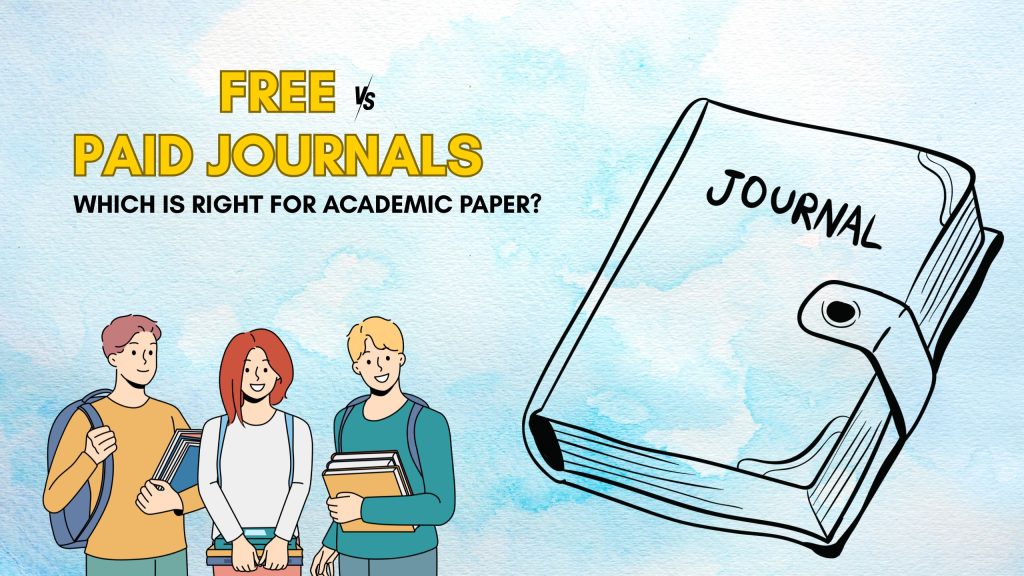Selecting the right journal for publishing an academic paper is a critical decision that can shape a researcher’s career, influence the reach of their work, and impact the academic community. The choice between free (open access) and paid (subscription or author-pays) journals involves weighing factors like cost, accessibility, and prestige. To guide researchers through the differences, advantages, and challenges of both options to help them make an informed decision that aligns with their goals.
What are Free Journals?
Free journals, often referred to as open access (OA) journals, provide unrestricted access to their content without charging readers or, in some cases, authors. These journals fall into two main categories: “gold” open access, where articles are freely available upon publication, and “green” open access, where authors can archive their work in repositories.
Funding Models
Free journals are typically funded through institutional subsidies, grants, or sponsorships from academic societies or governments. Some may charge minimal fees for additional services, but true free journals do not impose article processing charges (APCs).
Benefits
- Accessibility: Articles are available to a global audience, including researchers in low-resource settings.
- Audience Reach: Open access increases visibility, potentially leading to higher citation rates.
What are Paid Journals?
Paid journals operate on two primary models: subscription-based, where readers or institutions pay for access, or author-pays, where authors cover APCs to make their work open access in a hybrid or fully OA journal.
Typical Costs
- Subscription Journals: Readers pay through institutional or individual subscriptions, often costing hundreds to thousands of dollars annually.
- APCs: In author-pays models, APCs range from $500 to $5,000 per article, depending on the journal’s prestige and field.
Business Models
Revenue comes from subscriptions, APCs, or a combination (hybrid journals). Prestigious journals often rely on subscriptions from academic institutions, while APC-based models are common in open access journals.
Key Differences Between Free and Paid Journals
| Aspect | Free Journals | Paid Journals |
|---|---|---|
| Cost to Authors | None or minimal | APCs ($500–$5,000) or no cost if subscription-based |
| Accessibility | Freely accessible to all | Often behind paywalls, unless APCs paid |
| Impact Factor | Varies, often lower | Often higher, tied to prestige |
| Publication Timeline | Can be slower due to limited resources | Often faster, especially with APCs |
| Copyright/Licensing | Typically Creative Commons (CC BY) | Restrictive or CC BY if OA |
Advantages of Publishing in Free Journals
- Wider Visibility: Open access ensures anyone with internet access can read the paper, increasing its reach and potential impact.
- No Cost Barriers: Authors with limited funding can publish without financial strain.
- Support for Open Science: Free journals align with the ethos of open knowledge sharing, benefiting the global research community.
Advantages of Publishing in Paid Journals
- Higher Impact Factors: Many paid journals, especially subscription-based ones, have established reputations and higher impact factors, valued in academic evaluations.
- Rigorous Peer Review: Paid journals often have robust peer-review processes, though quality varies.
- Faster Publication: Some paid journals, particularly those with APCs, offer expedited timelines to attract authors.
Challenges and Considerations
- Predatory Journals: Free or low-cost open access journals may include predatory publishers with lax peer review or questionable practices. Researchers must verify journal credibility.
- Financial Barriers: APCs in paid journals can be prohibitive, especially for early-career researchers or those without grants.
- Institutional Mandates: Some funding bodies or institutions require open access publishing, which may limit choices.
- Career Impact: Paid journals with higher impact factors may carry more weight in hiring, tenure, or promotion decisions.
How to Choose the Right Journal for Academic Paper?
Choosing a journal requires aligning your priorities with practical constraints:
- Research Goals and Audience: If global reach is critical (e.g., for public health research), free OA journals may be ideal. For niche fields, a prestigious paid journal may better target specialists.
- Budget: Assess funding availability for APCs. Free journals are viable if budgets are tight.
- Reputation and Indexing: Check if the journal is indexed in databases like Scopus or Web of Science. Use tools like the Directory of Open Access Journals (DOAJ) for credible free journals.
- Publication Timeline: If speed is crucial, compare journal turnaround times.
- Copyright Terms: Ensure the journal’s licensing aligns with your reuse needs (e.g., Creative Commons for broader sharing).
Case Studies
1: Success with a Free Journal
Dr. Maria, an early-career ecologist, published her study on urban biodiversity in a free OA journal supported by her university. The paper reached policymakers and NGOs globally, leading to citations and a collaborative grant. The lack of APCs allowed her to publish without dipping into her limited research funds.
2: Opting for a Paid Journal
Dr. Ahmed, a medical researcher, chose a high-impact subscription journal for his clinical trial results. The journal’s prestige and rigorous peer review enhanced his paper’s credibility, contributing to his successful tenure application. He secured funding to cover the $3,000 APC for open access.
Free journals offer unmatched accessibility and align with open science but may lack the prestige of some paid journals. Paid journals provide credibility and faster publication but come with financial and access barriers. Researchers should evaluate their goals, budget, and institutional requirements, using resources like DOAJ or Journal Citation Reports to assess journal quality. Careful research and due diligence ensure your work finds the right home, maximizing its impact and advancing your career.
FAQs
1. What is the main difference between free and paid journals?
Free journals, often called open access journals, allow readers to access articles at no cost and usually don’t charge authors for publishing. Paid journals typically require readers or institutions to pay subscription fees or charge authors Article Processing Charges (APCs) to publish.
2. Are free journals less reputable than paid journals?
Not necessarily. Many free (open access) journals maintain high standards and rigorous peer review. However, some predatory journals may misuse the open access model, so it’s important to verify a journal’s reputation before submitting.
3. How do free journals fund their operations if they don’t charge authors?
Free journals often receive funding through institutional support, grants, sponsorships, or academic societies, allowing them to cover editorial and publication costs without charging authors.
4. What are Article Processing Charges (APCs)?
APCs are fees charged by some journals (usually open access) to authors for processing and publishing their articles. These fees help cover editorial and production costs.
5. Can publishing in free journals help my research get more visibility?
Yes. Because free journals are accessible to anyone without paywalls, your research can reach a broader audience, potentially increasing citations and impact.
6. Do paid journals always have higher impact factors than free journals?
Many high-impact journals are paid or subscription-based, but there are also reputable free journals with strong impact factors. Impact depends on the journal’s quality, editorial policies, and field of research.
7. Are there risks associated with publishing in free/open access journals?
Yes, the main risk is encountering predatory journals that lack proper peer review or editorial oversight. Researchers should carefully check journal credentials, indexing, and reviews before submitting.
8. How do I decide which journal is right for my paper?
Consider your research goals, funding availability, target audience, journal reputation, indexing, publication speed, and copyright terms. Balance accessibility with prestige and cost.
9. Can institutions or funders require me to publish in open access journals?
Yes. Many funding agencies and universities have open access mandates requiring researchers to make their work freely available, which may influence journal choice.
10. Will publishing in a paid journal improve my academic career?
Publishing in reputable paid journals with strong impact factors can enhance your academic profile, but the overall quality and relevance of your research remain most important.



